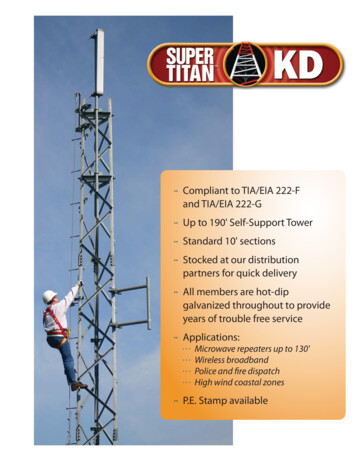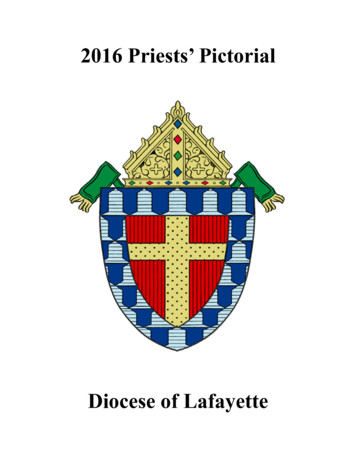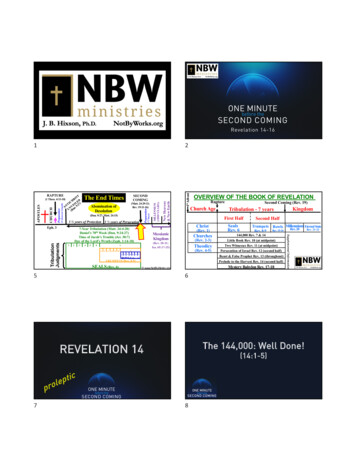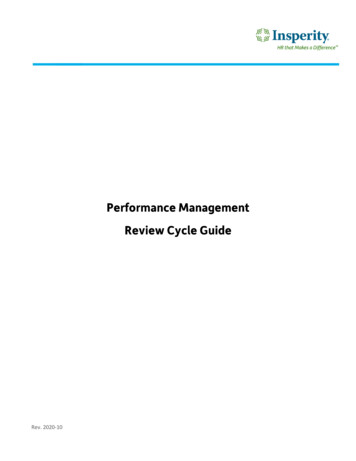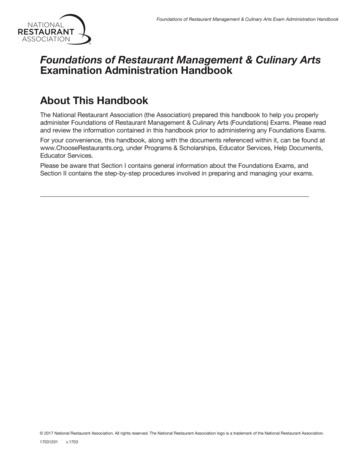
Transcription
Foundations for Implementation - Day 1 CPM Educational Program. All rights reserved. cpm.org
OpeningCPM Learning Event Series, Day 1“Teaching is a delayed gratification job, the fruits of my labor will be seen muchafter they leave my room. I am appreciated and they will thank me later.”Tatiyana WebbSign in and make a name tagGet a puzzle piece and find other participantswho have a representation of the same line.This is your team for the day!2
Foundations for ImplementationDay 1Nameemail@cpm.org
OpeningHousekeeping Bathrooms 8:00 AM – 4:00 PM Breaks scheduled and as needed Lunch Parking Lot Poster Supply/Resource Table4
OpeningLearning Event eBook AccesseBooksenroll.cpm.orgEnrollment PIN####5
OpeningProfessional Learning Portalprofessionallearning.cpm.orgImplementation Action PlanContent ModulesLearning LogInstructional ModulesFile CabinetInclusion Modules6
OpeningFoundations for Implementation SeriesSchool YearSummerIn-Person Learning EventsVirtual Learning EventsIntroduction to FoundationsIntroduction to FoundationsOn-Demand ModuleOn-Demand ModuleDays 1 - 3Sessions 1-6Live Learning EventLive Virtual LearningInstructional Modules (IM)Instructional Modules (IM)On-Demand IM 1 -3 (remaining activities)On-Demand IM 1 - 3Content Modules (CM)Content Modules (CM)On-Demand CM 1- 2 (remaining activities)On-Demand CM 1- 2Days 4 and 5Sessions 7 - 10Live Learning EventLive Virtual LearningInstructional Modules (IM)Instructional Modules (IM)On-Demand IM 4 - 5 (remaining activities)On-Demand IM 4 - 5Content Modules (CM)Content Modules (CM)Any 4 additional On-Demand CMsAny 4 additional On-Demand CMs7
OpeningIgnite8
OpeningIcebreaker1.One team member draws two concentric circles on a piece of paper.2.Divide the outer ring into equal parts (one part for each team member).3.Each team member writes their name outside a section.4.Find something unique about each teammate and write it in their section.5.When each person has something written, find something that the wholeteam has in common and write it in the inner circle.9
OpeningClassroom Agreements Clear tables (or desks) before getting to work. Keep the conversation centered on math. Use the Ask Three Then Me protocol Helping does not mean giving answers. Work together as a team – your team is not done until every teammember is finished! Explain and justify your ideas. Give reasons! Keep conversations within the team.10
Team Building ActivityCCA Lesson 1.1.1(INT I Lesson 1.1.1)Solving Puzzles in TeamsMath goal:Work together as a team to consider the output ofvarious composite relations.Team goal:Work collaboratively using team roles.11
Team Building ActivityDebrief CCA Lesson 1.1.1(INT I Lesson 1.1.1)Solving Puzzles in TeamsHow did workingin study teamshelp you be moreeffective learnersduring this lesson?How can workingin study teamshelp yourstudents?What might youlearn about whatyour studentsknow by the end ofthis lesson?12
Team Building ActivityMathematics Teaching PracticesDiscuss with your team how the NCTM’s Effective Mathematics TeachingPractice on your table was evident in the lesson you just experienced.Recorder/Reporter be prepared toshare one way the standard wasevident with the whole group(NCTM 2014)13
Team Building ActivityChapter 1 is UNIQUE! Collaboration - Effective Study Teams Previews the Course Topics Intent of Review & Preview Formative Assessment14
Outcomes and AgendaElements“The implications are clear. Curriculum matters, buthow teachers use curriculum matters even more.”Short, J., & Hirsh, S. (2020). The elements: Transforming teaching through curriculum-based professional learning.Carnegie Corporation of New York, 9.15
Outcomes and AgendaEffective Math Teaching PracticesFocus of the day:Establish goals to focus learning.16
Outcomes and AgendaOutcomesParticipants.establish team agreements and team roles that clearly defineexpectations for multiple modes of instruction.build professional relationships and learning communities toimprove math learning.make connections between NCTM’s Effective MathematicsTeaching Practices (NCTM, 2014) and the design of CPMcurriculum.17
Opening and AgendaAgendaFocus: Collaborative Learning Opening CPM Research Summary Collaborative Learning Assessment Thread Chapter 1 Walkthrough ClosureEffective Study TeamsModel Lessons18
Outcomes and AgendaLearning Agreements Actively engage in all activitiesand discussions.Critically analyze ideas butnot people.Be willing to take risks Focus on solutions andactions.Be visionary.Explore your beliefs aboutteaching and learning.Change takes time, effort and supportFOR TEACHERS as well as students!19
Research ConnectionsStarting with Core Beliefs“Teachers’ beliefs influence the decisions thatthey make about the manner in which they teachmathematics Students’ beliefs influence theirperception of what it means to learn mathematicsand their dispositions toward the subject.”(NCTM, 2014, pp. 10-11)20
Research ConnectionsBeliefs About Teaching and Learning MathematicsLessProductivetoMoreProductive21
Research ConnectionsBeliefs About Teaching and Learning Mathematics: Team RolesFacilitator - Start the activity by having a team member read one statementand discuss it as a teamResource Manager - Collect the materials for the sort for your team anddistribute them to your teammates.Recorder/Reporter - Make sure all members have a chance to share.Task Manager - Ask everyone to justify their reasoning as they read andshare their thinking about each statement.22
Research ConnectionsBeliefs About Teaching and Learning Mathematics(NCTM, 2014, p. 11)23
Research ConnectionsStarting with Core Beliefs“It is important to note that these beliefs should not beviewed as good or bad. Instead, beliefs should beunderstood as unproductive when they hinder theimplementation of effective instructional practice orlimit student access to important mathematics contentand practices.”(NCTM, 2014, p. 11)24
Research ConnectionsStudy Team and Teaching StrategiesTurn & TalkGlow and Grow Student shares one topic, teamagreement, or idea that is astrength—Glow.Student shares one topic, teamagreement, or idea whereimprovement is needed—Grow. Students work in pairs.Team Member (1) listens whileTeam Member (2) explains the firstproblem.Team Member (1) asks clarifyingquestions to Team Member (2).Partners share explanation with therest of the team.Roles are reversed for the nextproblem.25
Research ConnectionsDebrief of BeliefsGlow and Grow1. Select one belief that is a strength.2. Select one belief where you have room to grow.With your elbow partner:Turn and Talk26
Research ConnectionsReading ProtocolGolden LineRead the article, highlight or note parts of the research that: raise questions for youconfirm what you already believemake you say, “Ah Ha”conflict with your beliefscause you to reconsider prior assumptionsChoose 1-2 “golden lines” to share out.27
Research ConnectionsCollaborative Learning - Why?Synthesis of Research on Cooperative LearningCollaborative LearningeBook:Click on the Teacher Tab on the left sideNext choose Program DescriptionSelect the tab Research1: CL28
Research ConnectionsGolden Line Reading ProtocolRead the article, highlight or note parts of the research that: raise questions for youconfirm what you already believemake you say, “Ah Ha”conflict with your beliefscause you to reconsider prior assumptionsChoose 1-2 “golden lines” to share.29
Research ConnectionsGolden Line Reading ProtocolShare your golden line with your team members and explaintheir connections to each line.Task Managers decide who shares firstand make sure everyone in the team hasa chance to share.30
Research ConnectionsThree Pillars of CPMAttaining Long Term Knowledge Collaborative Learning Problem-Based Learning Mixed, Spaced Practice31
Research ConnectionsCPM Guiding PrinciplesStudents deepentheirmathematicalunderstandingwhen they areengaged withconcepts overtime.Students havesignificantlybetter retentionof mathematicswhen conceptsare grounded incontext.Student’sinvolvement ineffective studyteams increasestheir ability tolearnmathematics.Effective studyteams areguided,supported andsummarized by areflectiveknowledgeableteacher.Assessing whatstudentsunderstandrequires morethat one methodand more thanone opportunity.When studentsand stakeholdersembrace agrowth mindset,they understandthat masterytakes time, effortand support.32
Research ConnectionsStudy Team and Teaching StrategiesWalk and Talk Partners receive topic or concept to discuss.Partners summarize, clarify ideas, or ask questions whilewalking.Partners share any remaining questions with the teacher afterreturning to their desks.33
Research ConnectionsDebrief ConnectionsWalk and TalkWith your elbow partner go for a five minute walk and discussthe following:What connections do you see between NCTM’s beliefstatements and the Synthesis of Research onCollaborative Learning?34
Take a breakEssential Actions: What are your questions about your ContentModules? What are your questions about yourInstructional Modules? Did you complete Introduction to Foundations?
Creating Effective Study TeamsCollaborative Learning - How?How do we create an environment for effective collaborative learning?Establish andmaintainTeam Rolesand TeamAgreementsIntentional useof Study Team& TeachingStrategies(STTS)Circulation,questioning, &teaminteractions36
Creating Effective Study TeamsStudy Team and Teaching StrategiesThink-Pair-Share Teacher poses a question/problem.Students think for a period of time—one or two minutes.Students silently prepare an explanation to share.Partners take turns sharing explanations.Partners may then share out with the rest of the team or class.37
Creating Effective Study TeamsIntroduction to Positive InterdependenceTHINK - PAIR - SHAREHow would you define positive interdependence?Why is it important in collaborative learning?38
Creating Effective Study TeamsPositive Interdependence“Positive interdependence arises whenstudents feel mutual accountability for theirlearning and believe that their own learningwill benefit through their interactions witheach other.”(Horn, 2012, p. 47)39
Creating Effective Study TeamsConnecting Team Roles“Two marks of productive group discussionare a creative interchange of ideas andwell-distributed participation. These aresigns of positive interdependence.Students must be taught ways ofinteracting that support this ideal.”(Horn, 2012, p. 50)40
Creating Effective Study TeamsStudy Team and Teaching StrategiesJigsaw (Four Corner ) Each study team role visits a different corner of the room.Each corner receives a different topic or concept.An explanation of the topic or concept is created.Team members return to original team.Each member presents the assigned topic or concept to team.41
Creating Effective Study TeamsTeam RolesResource ManagerFacilitatorDiscuss:What questions will you need to ask team members?What behaviors will you encourage within your team?How do you see this role impacting your interactions with the teacher, etc.Please make sure everyone has opportunity for input.Task ManagerRecorder/Reporter42
Creating Effective Study TeamsTeam Roles Return to your team. Each team member shares their newlygained information about the team role.Please make sure everyone has opportunity to share.FacilitatorResource ManagerTask ManagerRecorder/Reporter43
Creating Effective Study TeamsEstablishing Team RolesTeam Roles are supported in all CPM courses Lesson Specific Resource Pages provided in Chapter 1 ineach course.General Team Roles are also provided in the teacher notesAssigning and Displaying Roles Placemats, Table Tents, Name Cards, Lanyardsand more can be found in the CPM eBooksTeacher Tab Team Support Team Resources44
Creating Effective Study TeamsClassroom Agreements and Positive Interdependence“If interdependence is a value,teachers need to consistentlycommunicate its worth throughclassroom norms, [and]routines ”(Horn, 2012, p. 48)45
Creating Effective Study TeamsTeam Norms JigsawJigsaw1.Read the team norm assigned to your team.2.Discuss how the team norm supports establishing effectivestudy teams3.Complete a Looks Like - Sounds Like - Feels Like Y-chart46
Creating Effective Study TeamsTeam Norms JigsawJigsawFacilitator - make sure everyone has a voicePlace normhereResource Manager - get materials for the activityRecorder/Reporter - make sure everyone’s voiceis visible on the posterTask Manager - keep track of time47
Creating Effective Study TeamsStudy Team and Teaching StrategiesGallery Walk Teams display posters or presentations. Students explain and critique displayed work. Students rotate to each location. Feedback is given.48
Creating Effective Study TeamsDebrief of Team NormsGallery Walk1. Resource Manager hang your poster somewhere in the room2. Individually do a Museum Gallery Walk (silent) to view all posters3. Make sure you visit all the poster.4. Remember - this is a silent Museum Gallery Walk.49
Creating Effective Study TeamsStudy Team and Teaching StrategiesHosted Gallery Walk50
Creating Effective Study TeamsIgnite Your ClassroomStart promptly.Peer support expected within each team.Active learning.Respond to the team rather than individuals.Circulate. Circulate. Circulate.Closure. Closure.Why are these actions essential tocollaborative learning?51
Creating Effective Study TeamsCollaborative Learning ExpectationsTogether, work to learn mathematicsExplain and give reasonsAsk questions and share ideasMembers of your team are your first resourceStronger together than apart52
Creating Effective Study TeamsCPM Guiding PrinciplesStudents deepentheirmathematicalunderstandingwhen they areengaged withconcepts overtime.Students havesignificantlybetter retentionof mathematicswhen conceptsare grounded incontext.Student’sinvolvement ineffective studyteams increasestheir ability tolearnmathematics.Effective studyteams areguided,supported andsummarized by areflectiveknowledgeableteacher.Assessing whatstudentsunderstandrequires morethat one methodand more thanone opportunity.When studentsand stakeholdersembrace agrowth mindset,they understandthat masterytakes time, effortand support.53
Creating Effective Study TeamsLearning Log ReflectionTitle: Supporting Effective TeamsHow will team roles and collaborative learning agreementshelp support and maintain effective study teams in yourclassroom?54
Collaborative Learning, Part 1Team Role Placemat55
Collaborative Learning, Part 1Team Role Placemat - Video56
Collaborative Learning, Part 1Standards for Mathematical Practice57
Collaborative Learning, Part 1CC3 Lesson 1.1.2:Finding and Generalizing PatternsMath goal:Extend tile patterns and generalize the geometric patternTeam goal:Develop new ways of thinking about math58
Collaborative Learning, Part 1Debrief CC3 Lesson 1.1.2:Finding and Generalizing PatternsWhat is thegoal of thislesson?Which Standardsfor MathematicalPractice wereevident?What might youlearn about whatyour studentsknow by the end ofthis lesson?59
Collaborative Learning, Part 1CPM Principles of Assessment1. Teachers need to be involved in the crafting of assessments.2. Teachers need to read and work through all test problems.3. Students should be assessed only on content with which they havebeen meaningfully engaged.4. Formative assessment is a learning experience for students andteachers.5. While teachers are required to evaluate and assign grades, gradingshould be flexible.60
Collaborative Learning, Part 1CPM Principles of AssessmentRead: Principles of Assessment IntroductionFourth Principle: Formative assessment is a learning experience forboth the students and teacher.Focus Question:How does working in collaborative teams support formative assessment?eBook:Click on the Teacher Tab on the left side.Next choose Assessment Guidebook.Open the PDF for CPM Principles of Assessment.61
Collaborative Learning, Part 1Learning Log ReflectionTitle: Making ConnectionsWhat connections do you see between the CPM GuidingPrinciple and the fourth CPM Principle of Assessment?CPM Guiding Principle: Effective study teams are guided, supported andsummarized by a reflective knowledgeable teacher.CPM Principle of Assessment #4: Formative assessment is a learningexperience for both the student and the teacher.62
Lunch TimeReturn by:Essential Actions: What are your questions about your ContentModules? What are your questions about yourInstructional Modules? Did you complete Introduction to Foundations?
Collaborative Learning, Part 2Icebreaker1. Everyone in the group gets 10 pennies/toothpicks/scraps of paper, etc.2. The first person states something they have done (e.g. “I have waterskied”)3. Everyone else who has done the same thing admits it and puts onepenny in the middle of the table.4. Then the next person states something (e.g. “I have eaten frogs’ legs”)5. Everyone who has done it puts another penny in the center.6. Continue until someone has run out of pennies.64
Collaborative Learning, Part 2Study Team and Teaching StrategiesPick Three Teacher posts a list of strengths.Each student selects and writes down three strengths they cancontribute to their team. Students take turns sharing their strengths with their team. Students use strengths as they work on the lesson.65
Collaborative Learning, Part 2Pick Three: Potential StrengthsPick ThreeLooking for patternsPredictingDrawingFollowing directionsHelping othersWriting equations from patternsExplaining my thinkingLooking at things in different waysNoticing detailsReading aloudKeeping people on taskJustifying answersOrganizingBeing positive66
Collaborative Learning, Part 2CCG Lesson 1.1.3 (Int II Lesson 1.2.2)Perimeter and Area of Enlarging Tile PatternsMath goal:Build an understanding of area and perimeterTeam goal:Use your personal strengths to support problem solving67
Collaborative Learning, Part 2Debrief CCG Lesson 1.1.3 (Int II Lesson 1.2.2)Perimeter and Area of Enlarging Tile PatternsWhat is the goalof this lesson?Which Standardsfor MathematicalPractice wereevident?How did the PickThree strategyenable allparticipants toengage with theirstudy team?68
Collaborative Learning, Part 2Teacher NoteseBook:Click on the Teacher Notesat the top of the lesson.69
Take a breakEssential Actions: What are your questions about your ContentModules? What are your questions about yourInstructional Modules? Did you complete Introduction to Foundations?
Thread and Chapter WalkthroughThread71
Thread and Chapter WalkthroughNew TeamsPlease sit together in teams of 4 with same course teachers.Options: All 4th years courses (Precalculus, Statistics, Calculus) at one tableCo-Teachers join the team of the course you teach or supportAssign team roles:Facilitator - first birthday in this yearResource Manager - second birthday in this yearRecorder/Reporter - third birthday in this yearTask Manager - fourth birthday in this year72
Thread and Chapter WalkthroughContent ModuleWhat is a Content Module?Intent ofContentModulesParticipatein ContentSessionsConnectionsto TheElements73
Thread and Chapter WalkthroughIntroduction to Content Modules74
Thread and Chapter WalkthroughChapter WalkthroughWhat is thegoal of thislesson? Whatshould yourstudents beable to do bythe end of thislesson?How will youuse team rolesin this lessonto supportstudentlearning?How will you useStudy Team andTeachingStrategies in thislesson tosupport studentstatus in theirteams?Whatexpectationswill you set forstudents tomaintaineffectivecollaboration?75
Thread and Chapter WalkthroughStudy Team and Teaching StrategiesWhiparound Teacher provides a prompt. Students take turns sharing brief comments. Students listen while others share.76
Thread and Chapter WalkthroughContent Module ClosureWhiparound: Share one thing you learned.Did you havean “aha”moment? Whatwas it?How was themath presenteddifferently fromwhat you havepreviouslyseen?How was thecontent differentfrom previouslyused curriculums?How are theproblems youare experiencingconnected toStudy Team andTeachingStrategies?77
Thread and Chapter WalkthroughImplementation Action PlanPrompts:1.My plan for establishing and maintaining team roles in my classroom is At least one actionable step I will commit to is.2.My plan for establishing and maintaining team agreements is At least one actionable step I will commit to is.Students need effective collaborative study teams to access rigorous mathematics.78
ClosureWhat have we learned?79
ClosureOutcomesParticipants.establish team agreements and roles that clearly defineexpectations for multiple modes of instruction.build professional relationships and learning communities toimprove math learning.make connections between NCTM’s Effective MathematicsTeaching Practices and the design of CPM curriculum.80
ClosureThree Pillars of CPM81
ClosureCPM Guiding PrinciplesStudents deepentheirmathematicalunderstandingwhen they areengaged withconcepts overtime.Students havesignificantlybetter retentionof mathematicswhen conceptsare grounded incontext.Student’sinvolvement ineffective studyteams increasestheir ability tolearnmathematics.Effective studyteams areguided,supported andsummarized by areflectiveknowledgeableteacher.Assessing whatstudentsunderstandrequires morethat one methodand more thanone opportunity.When studentsand stakeholdersembrace agrowth mindset,they understandthat masterytakes time, effortand support.82
ClosureTeacher TipsTeacher Actions That Support ImplementationUse the TeacherNotes as intended.Work all theproblems in thelesson ahead oftime, including theReview & Previewproblems.Create purposefullesson plans.83
ClosureFoundations for Implementation SeriesSchool YearSummerIn-Person Learning EventsVirtual Learning EventsIntroduction to FoundationsIntroduction to FoundationsOn-Demand ModuleOn-Demand ModuleDays 1 - 3Sessions 1-6Live Learning EventLive Virtual LearningInstructional Modules (IM)Instructional Modules (IM)On-Demand IM 1 -3 (remaining activities)On-Demand IM 1 - 3Content Modules (CM)Content Modules (CM)On-Demand CM 1- 2 (remaining activities)On-Demand CM 1- 2Days 4 and 5Sessions 7 - 10Live Learning EventLive Virtual LearningInstructional Modules (IM)Instructional Modules (IM)On-Demand IM 4 - 5 (remaining activities)On-Demand IM 4 - 5Content Modules (CM)Content Modules (CM)Any 4 additional On-Demand CMsAny 4 additional On-Demand CMs84
Register and get a 20%off code for onlinepurchases.Enter to win a reusableflipchart! A winner will bechosen every Friday!Go to wipebook.com/cpm85
Closure Parking Lot Attendance & FeedbackEither scan the QR codeOREnter passcode in the PortalXXXXXXXPUT QRCodeHERE Continuing Education Credit Tomorrow we will model a Typical Day Homework: CC3: Lesson 3.1.1: Review & Preview problems 3-4 through 3-8Note: Please complete these problems how you would expect your studentsto complete them.86
87
HOUSEKEEPINGANCHOR PAGELEARNING LOGTHREADWELCOMECONTENT MODULEPUZZLEMATH GOALTEAM GOALSTUDENT LENSTEACHER LENSEQUITY LENS88
Team Roles are supported in all CPM courses Lesson Specific Resource Pages provided in Chapter 1 in each course. General Team Roles are also provided in the teacher notes Assigning and Displaying Roles Placemats, Table Tents, Name Cards, Lanyards and more can be found in the CPM eBooks Teacher Tab Team Support Team Resources 44

